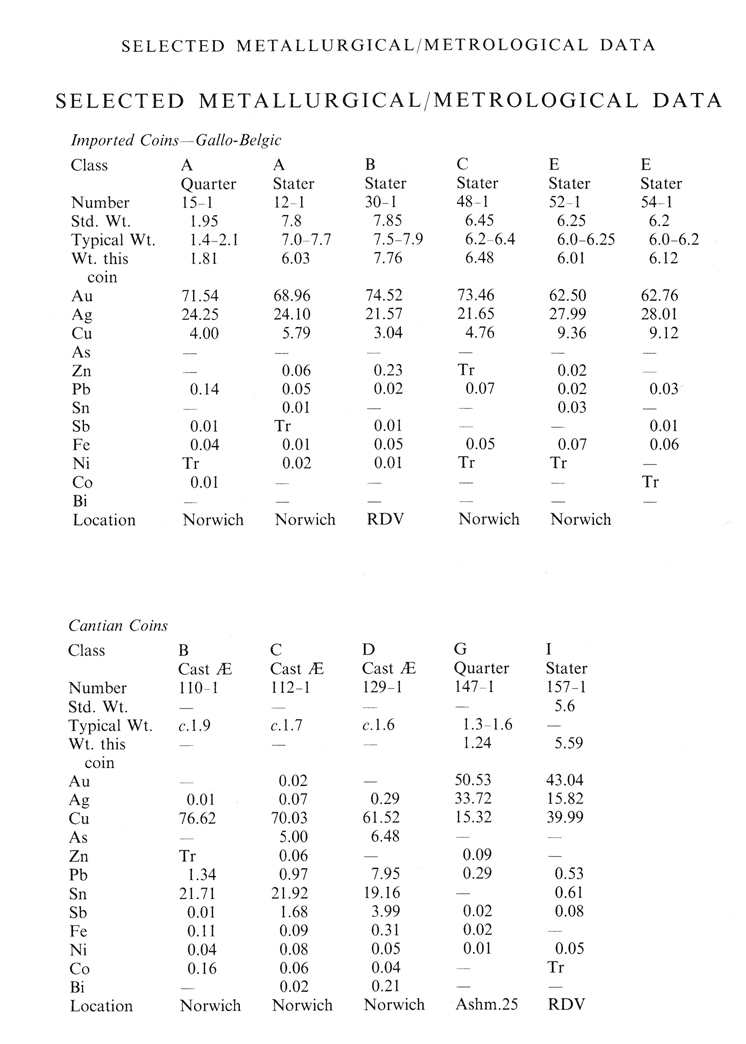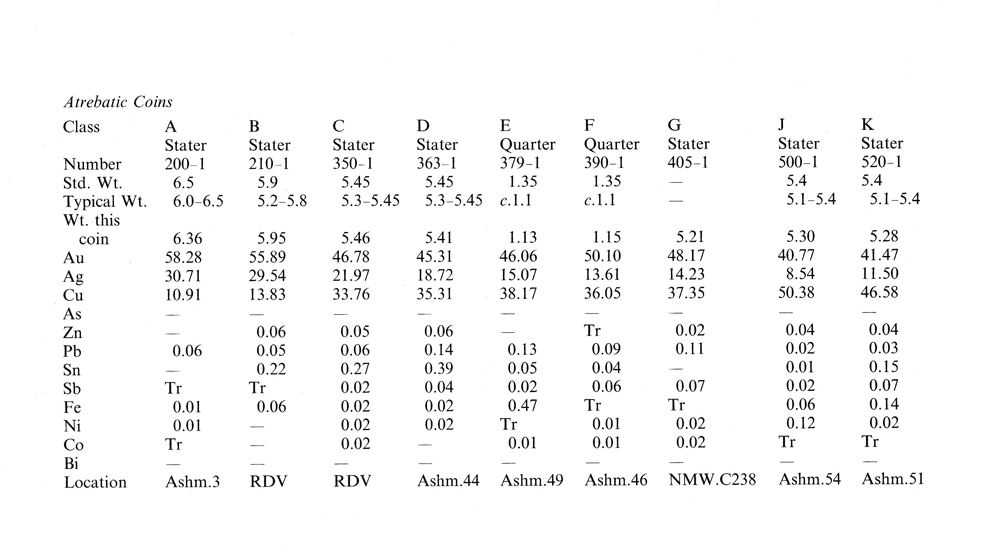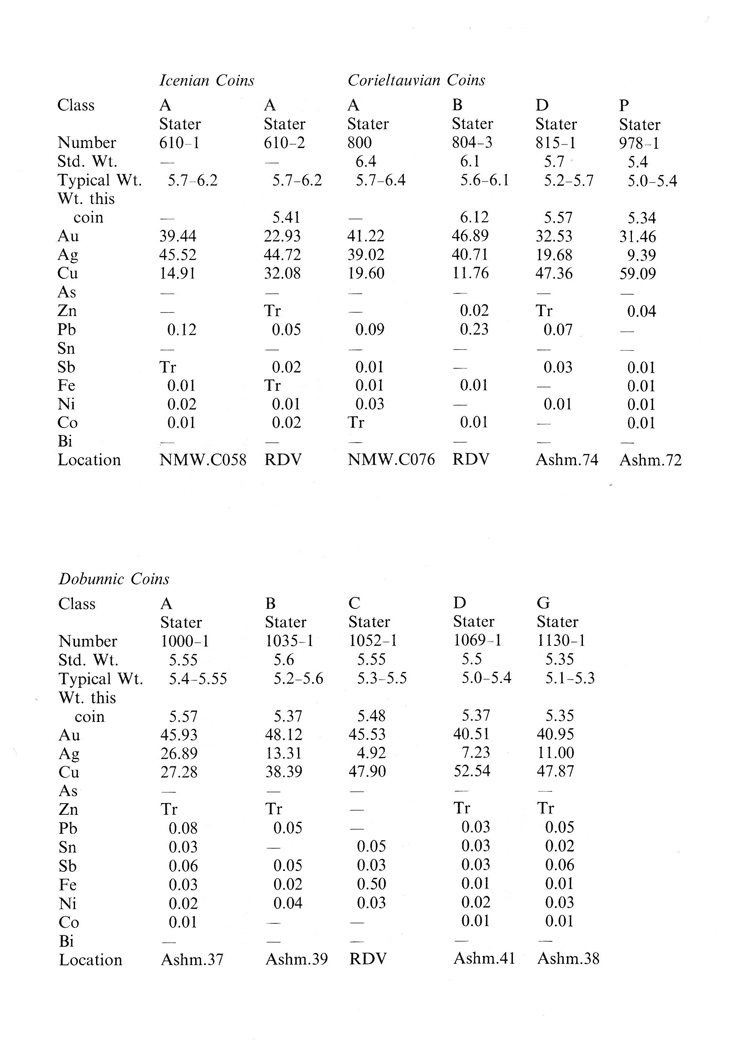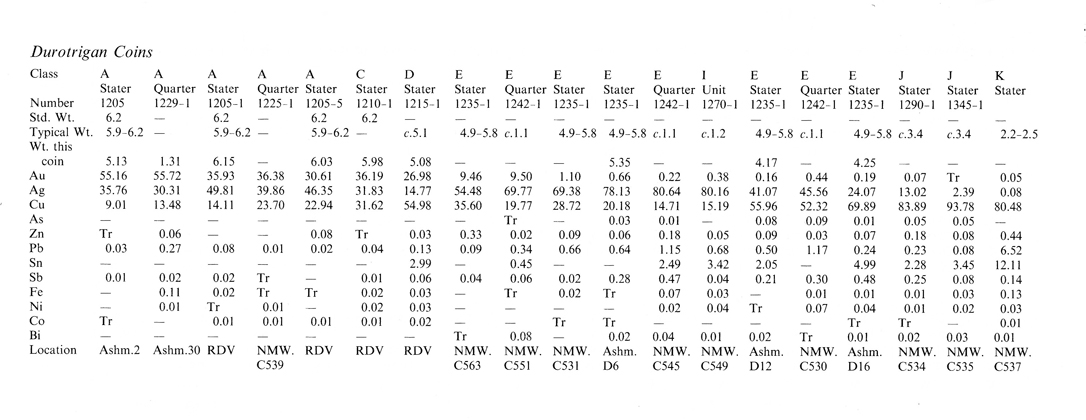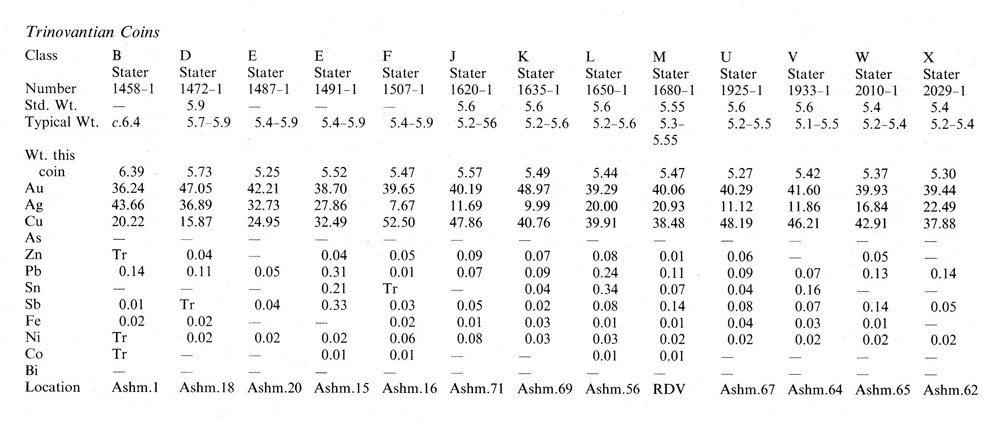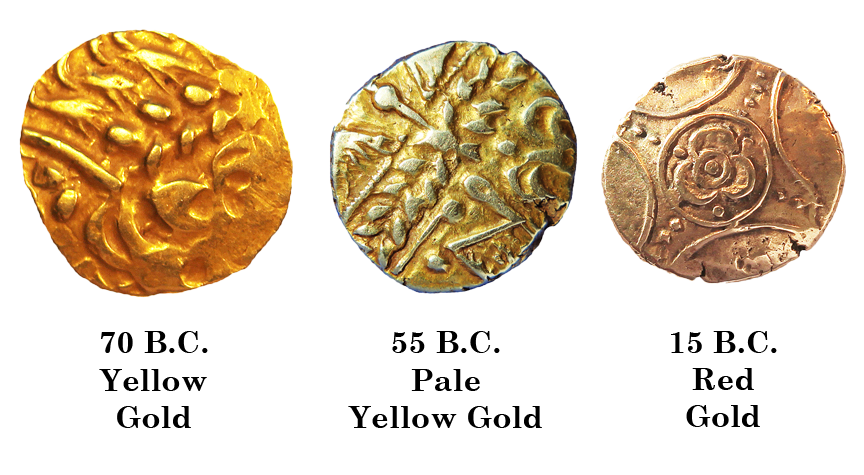
Metallurgy & Metrology
(Info)
Since the publication of Celtic Coinage of Britain in 1989, several important papers have been published about the metallurgy of the coins. These papers are the best source of information and greatly expand our understanding of the expertise of the Celtic mints. The relevant articles are Cowell 1992, Northover 1992 and Northover 1994. Viewers are urged to read these important contributions to Celtic numismatics.
The 1989 edition of Celtic Coinage of Britain contained summary metallurgical and metrological data to support the introductory text of the book. This information is reproduced below (with minor changes to reflect current tribal names).
The 1989 Discussion
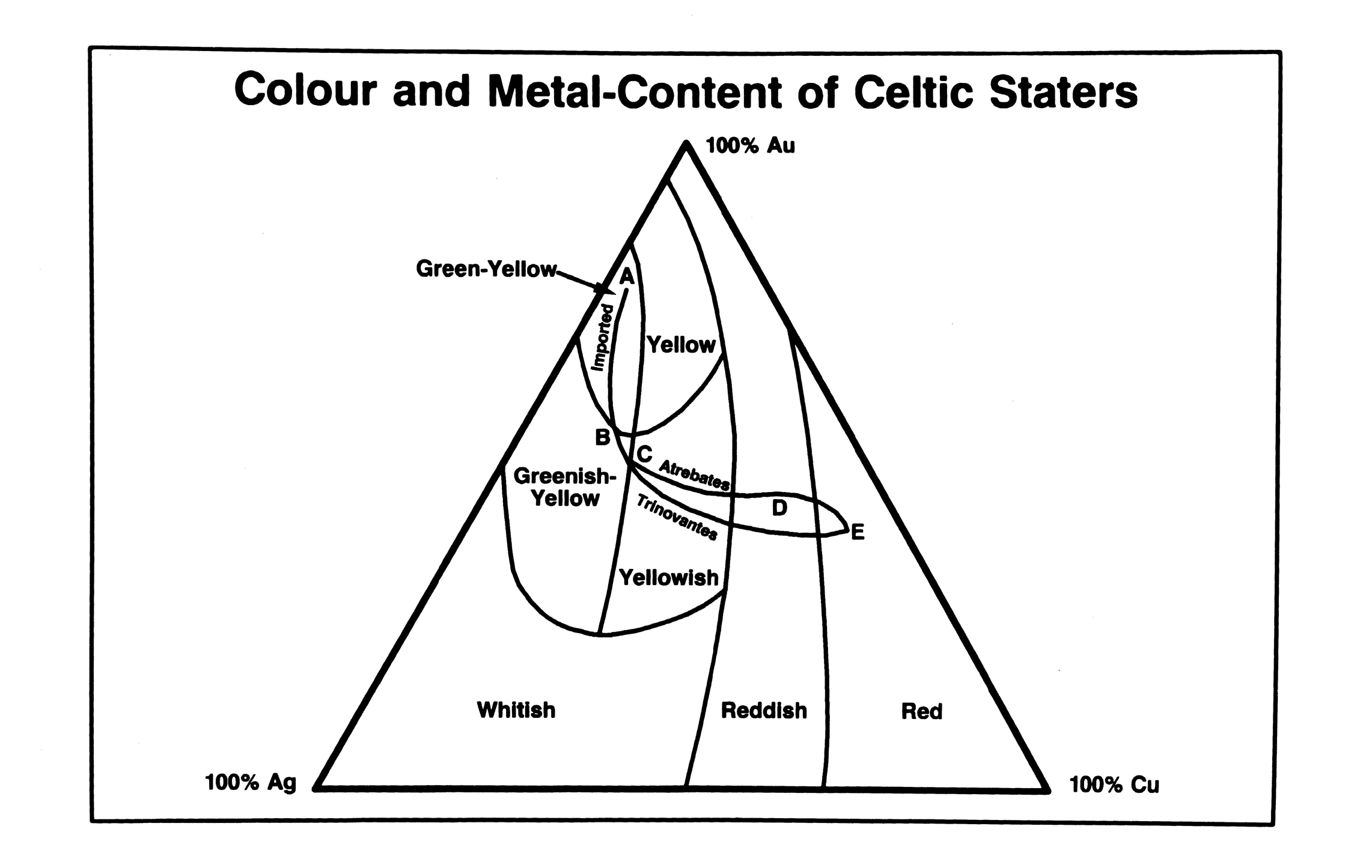
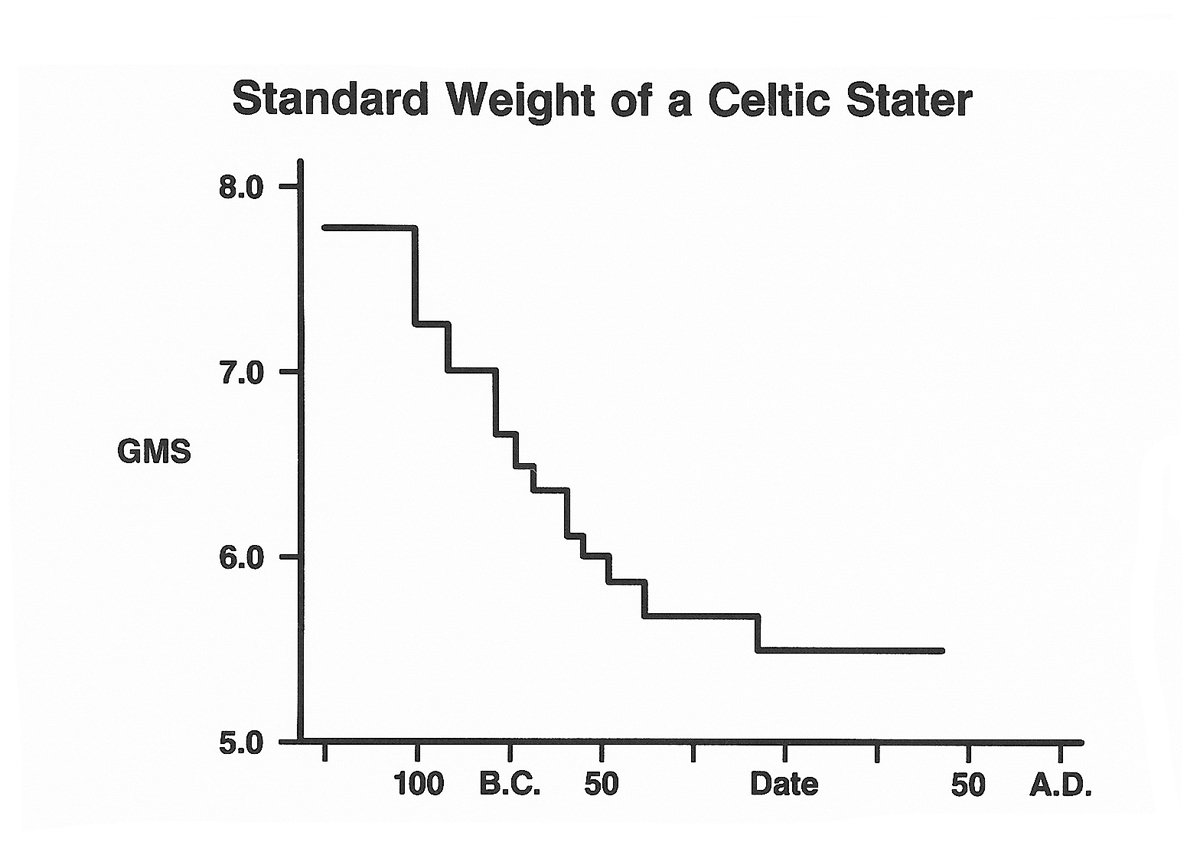
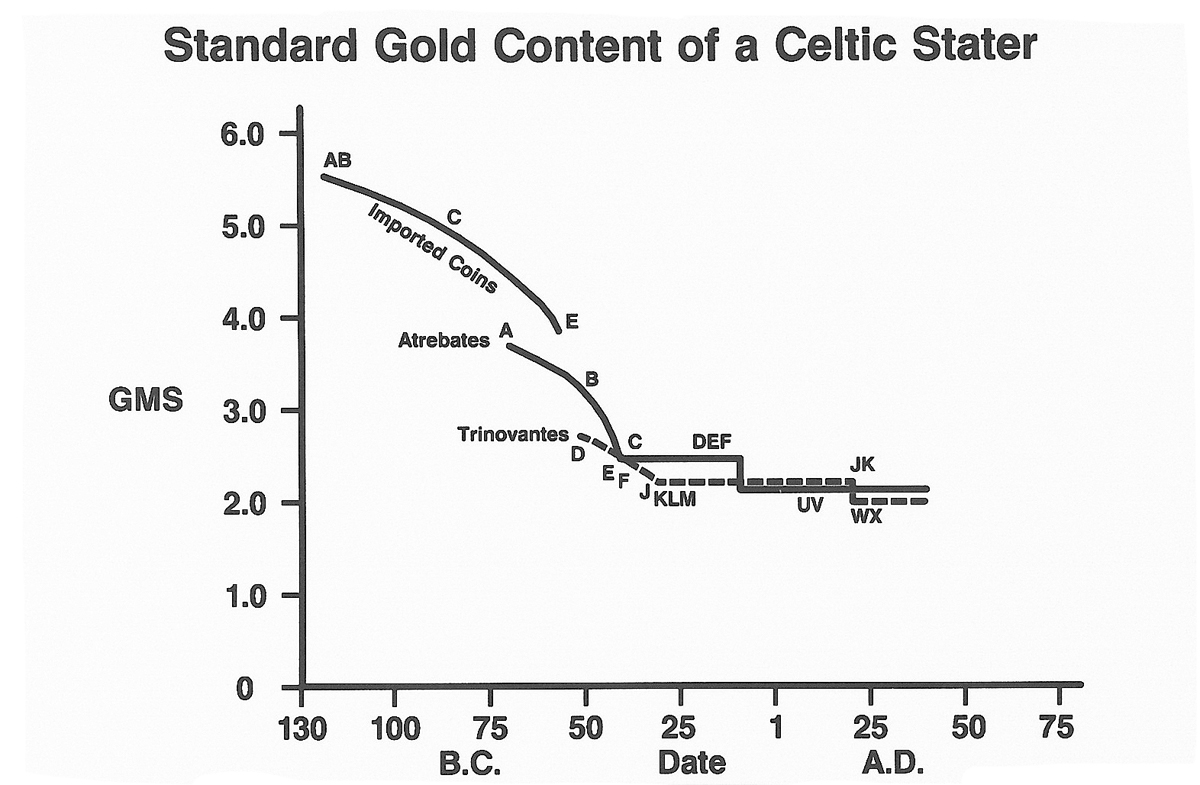
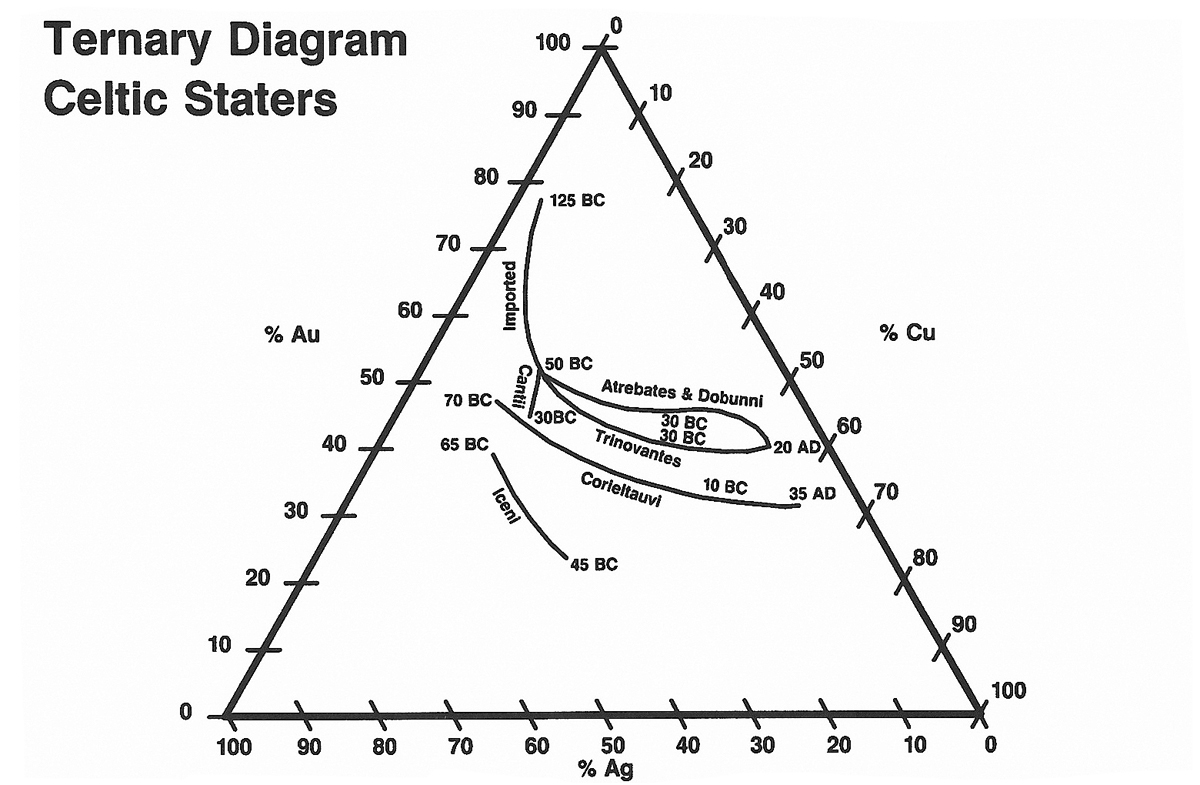
Standard Weights and gold alloys yield much of the evidence for dating the coins. The data are summarized in one table and five graphs. Statistical studies were used to create these summaries, but the details are not included in this book.
The table and graphs further illustrate some of the themes discussed in the section on Trend Surface Maps. At the end of this section, a discussion of the methods used to construct the table and graphs is given.
Theme 1 – The "Thames Mouth" Distribution
The British tribes did not strike coins until 75-70 BC., and by this time imported coins were appearing beyond the Thames mouth. The imported gold did, however, set the standard for the earliest British staters (126).
The first gold coins, Atrebatic A, Corieltauvian A and Trinovantian B (Westerham, North East Coast and Clacton Types), are derived from Gallo-Belgic C staters (Abstract Design Type), judging by the images on them. The British coins conform to the Standard Weight of the imported staters. The Cantii did not strike staters before the Gallic War, so the influence on their coinage cannot be seen.
We can judge the moneyers' metallurgical knowledge best for the Atrebates/Regni/Belgae because we have the best data for their coins (127). It appears the Atrebatic A stater not only had the correct Standard Weight, but contained roughly the correct amount of gold within ten percent, in fact. The Atrebates had tribal groups on both sides of the Channel, and it is not surprising they struck coins to the correct standard – they might have had access to the knowledge.
On the other hand, Corieltauvian and Trinovantian/Catuvellaunian data are scanty for the early period. A standard gold-content of perhaps 3.0 grammes is likely, but this would be a gramme and a half too light. Until better metallurgical data are available, judging the gold-content of the Corieltauvian A and Trinovantian B staters should be avoided.
The coin-metallurgy after the Gallic War is better understood. By this time, the Atrebates/Regni/Belgae and Trinovantes/Catuvellauni were striking coins with the same gold-content. Initially, the Atrebatic dynastic staters were slightly lighter than the Trinovantian ones, but this was compensated by having a correspondingly higher gold percentage. As a result, the coins of the two tribes had about the same intrinsic value. They continued to strike staters with equal gold-content for the next seventy years a remarkable coincidence of monetary practices.
Possibly the tribes formally agreed to standardize the weight and alloy. The mints had the technological means to produce coins with great precision, and different mints were producing coins with the same intrinsic value. Coordination of policy cannot be ruled out.
Theme 2 – Durotrigan Interaction
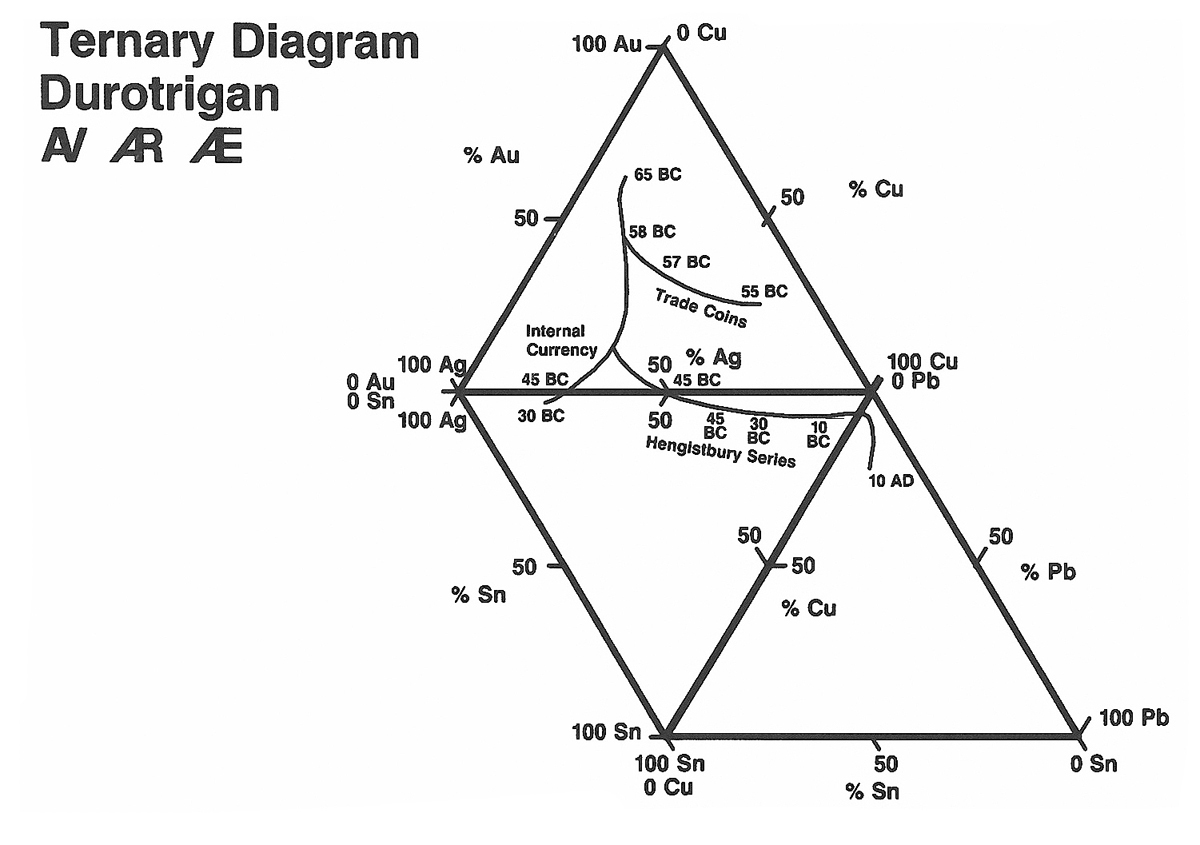
The Durotriges' initial coinage, the Durotrigan A stater (Chute Type) at first had a Standard Weight and gold-content roughly correct for the period. After the start of the Gallic War, however, the type quickly became debased (128).
Theme 3 – Durotrigan Isolation
The gold-content of the Durotrigan A stater rapidly dropped, and the type eventually became a silver coinage – the Durotrigan E stater (Abstract Type). The change to a silver coinage suggests the ties to Armorica, where silver coins were also used.
However, the Durotriges tried to maintain a trade coinage for use in Britain, despite their lack of gold bullion. The Durotrigan C and D staters (Chute/Cheriton Transitional and Cheriton Types) have a drastic reduction in intrinsic value as the Gallic War progresses, as seen in the rapid shift to the right on the Ternary Diagram. The D type is difficult to locate on the Ternary Diagram because of its tin content – it actually leaves the diagram, as the Durotriges add bronze to the alloy. These coins were eventually shunned in trade, and Durotrigan coins no longer circulated beyond the tribal territory.
Theme 4 – Trade Networks During the Gallic War
The extensive trading networks shown by the Trend Surface Maps are mirrored in the metrology and metallurgy of the coins. The Standard Weight and gold-content of the Atrebatic/Regnan/Belgic and Trinovantian/Catuvellaunian coinage converged during the Gallic War – evidently the coins had to be interchangeable in the trading networks. The similarity in intrinsic value of the two tribes' staters in the following period suggests the continuing influence of trade.
Eventually, the widespread circulation of Trinovantian/Catuvellaunian coin-age provided the standard by which all other coins were measured – the Corieltauvian dynastic staters, of correct weight but low gold-content, circulated primarily inside the tribe's territory. It appears the Dobunni were careful to strike coins with the correct intrinsic value, but more metallurgical analyses are required to prove this.
Theme 5 – Trackways in Britain
The metrology and metallurgy offer little insight, though the similarity in intrinsic value of the Atrebatic/Regnan/Belgic, Dobunnic and Trinovantian/Catuvellaunian staters suggests the influence of trade.
Theme 6 – Restricted Coin Distributions After the Gallic War
The Durotriges struck coins unique in weight and alloy, and these did not circulate beyond the tribe's territory. They no longer bothered to produce coins for external trade within Britain.
The Corieltauvi struck coins to the correct Standard Weight, but with a low gold-content – perhaps because the issues did not have to circulate beyond tribal territory. If the coins needed to circulate further, there might have been pressure to correct the deficient gold-content.
The Iceni struck extremely debased staters during and after the Gallic War, and there is no intermixture of Trinovantian/Catuvellaunian and Icenian issues. The Iceni corrected the gold-content about 45 BC. and within ten years, Addedomaros' coins were appearing in Icenian territory. The chain of events suggests trade may have been the motive behind the restoration of the Icenian stater. However, metallurgical analyses of Icenian coins are few, and inferences difficult to prove.
Theme 7 – Trinovantian/Catuvellaunian Expansion
The expanded influence of the Trinovantes/Catuvellauni is best seen in the widening circulation of their coins and the similarity in intrinsic value of staters throughout the south of Britain. The Dobunnic, Atrebatic/Regnan/Belgic and Trinovantian/Catuvellaunian staters were roughly interchangeable after 40 BC. It appears the widening circulation of the Trinovantian/Catuvellaunian staters was setting the standard for the other tribes, and possibly there was even a coordination of policy.
Theme 8 – Atrebatic/Regnan/Belgic Disfavour After the Gallic War
The metrology and metallurgy offer little insight.
Theme 9 – Atrebatic/Regnan/Belgic Incursion Into Kent
The metrology and metallurgy offer little insight.
Theme 10 – Dobunnic Rulers
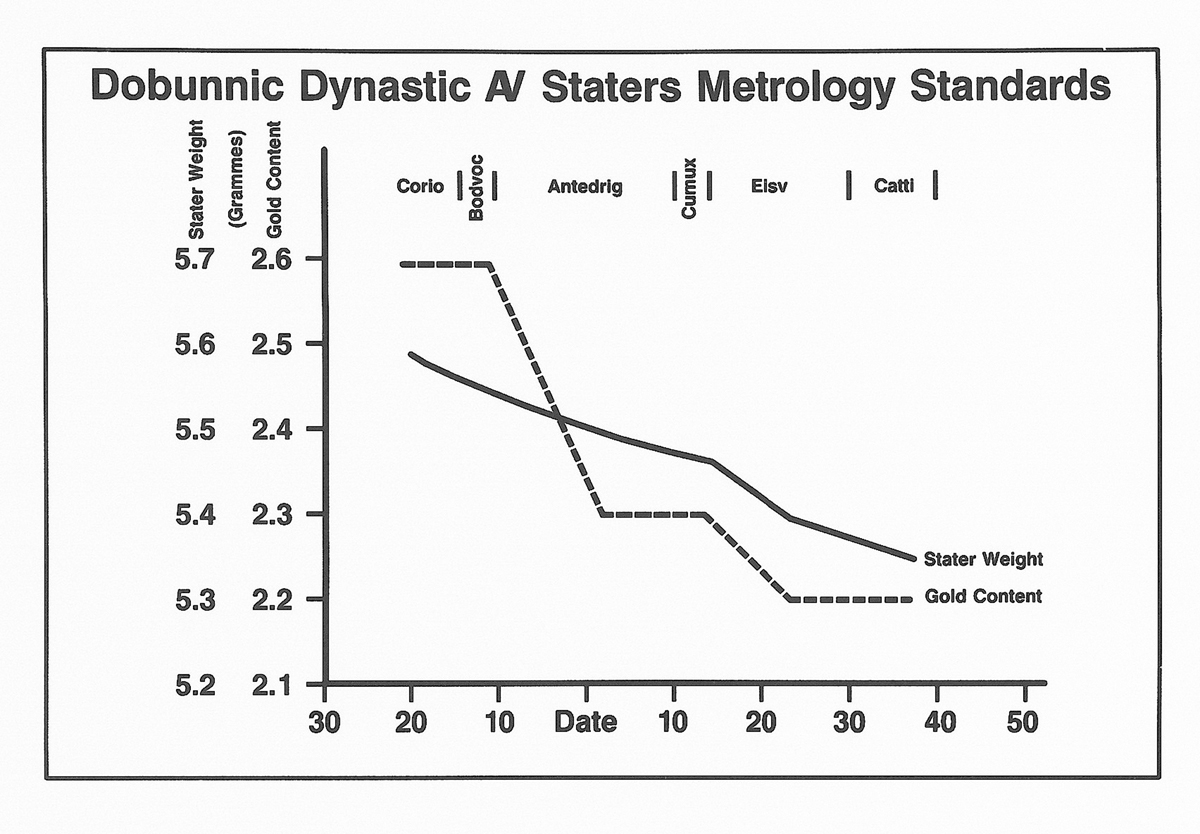
The Dobunnic coins may be arranged chronologically by the Standard Weight and gold-content of the staters (129). These measures decrease together, as they do for the coins of the other tribes, and this reveals the order of the Dobunnic Inscriptions.
Constructing the Table and Charts
All the metallurgical tests were performed by Peter Northover on an Electron Microprobe at the Department of Metallurgy and Science of Materials, Oxford University. The data are the averages of three measurements per coin. The Table "Selected Metallurgical and Metrological Data" gives the Standard and typical weights for the various types of gold issues, and a metallurgical analysis for selected coins. Some silver and bronze types are listed as well, where information is available. Several gold types are not represented because we lack the data – there is much work yet to be done.
The major constituents – gold, silver and copper are given, plus a trace-metal report. In most instances, more than one coin was measured, but not enough of them to perform statistical analyses. Thus measurements of individual, typical coins were selected for the Table. One important exception is the Trinovantian B stater, which is suspected to have a lower gold-content than other examples. The two Trinovantian B coins for which we have full metallurgical analyses both show this low gold percentage.
The five graphs give the Standard Weight and gold-content of a stater over time, and show how the alloys changed. The Standard Weight charts are based on frequency-histogram studies using a compilation of weights published in the past, including auction and sales catalogues, plus data collected by the author. The Gallo-Belgic, Trinovantian and Atrebatic gold-content chart was constructed from the Standard Weight and gold-content data from the coins listed in the Table. The Dobunnic gold-content chart was constructed from the Standard Weight data and an average of several metallurgical analyses. The Ternary Diagrams are based on the measurements of all the coins from the Electron Microprobe study, not just the ones in the Table, and make limited use of data published elsewhere.
The trend-lines drawn on the Standard Weight charts, gold-content charts and the Ternary Diagrams should be viewed as "illustrative". The coins vary from specimen to specimen in weight and alloy, and the lines attempt to show the average.
The alloys for the Atrebatic and Trinovantian gold, for example, overlap if all the coins are plotted. However, the Atrebatic pieces generally have a higher gold-content than the Trinovantian – hence the two lines show the difference.
Generally, reductions in Standard Weight and gold-content were made in a stepwise manner, but in certain cases the steps cannot be dated with precision. Whenever this occurs, the charts show a curved line, rather than a stepped one.
Metallurgical studies of silver units and bronze coins are only now being conducted. Indications are that the "struck bronzes" are primarily copper, with impurities of tin, silver, antimony and arsenic of up to one percent.
The Atrebatic silver units of Verica have silver percentages in the mid- nineties, with copper at one to three percent. The primary impurities are lead and zinc. These coins were likely struck from melted-down Roman denarii.
One AE unit of DIAS (1882 - 01), analyzed just before the first edition of this book went to press has proven to be made of brass. This coin was most likely made from a melted-down Roman coin.
The Data:

